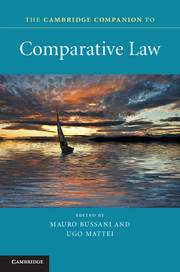Preface
Published online by Cambridge University Press: 05 May 2013
Summary
Comparative law means different things to different people, and each of these meanings can, in and of itself, be scientifically acceptable. Comparative law may be seen as the macro-comparison of the world’s legal systems; as the study of legal transplants – that is, of the borrowing of ideas between legal cultures and/or systems; as the most fruitful way of exploring the relationship between law and society, and the underlying perceptions of law; as well as the magnifying glass through which one best observes how state law lives side by side with other (supranational and domestic) sources of law and, thereby, how relative the notion of state power (as spread by mainstream political analysis) can be. This Companion goes through these and other possible meanings of comparative law, trying to show how the diverse working methods entailed by each of them can all be useful tools for the understanding of legal phenomena, as long as they stay close to what the law is and to how the law lives in the different settings – regardless of what one might like (and regardless of what any kind of personal and cultural bias may expect) the law to be.
This very approach also helps one realize how our discipline should, and this Companion does, take up the challenge launched by the fast evolving fields of international law and ‘global’ law. The latter areas are crowded – with some prominent exceptions – with experts whose cultural toolkits make the analysis focus largely on positive, or would-be positive (as is the case for most soft-law initiatives), legal rules. Comparative law, by contrast, looks at the law taking into consideration all the possible interactions between the primary sources, be they official or unofficial, dictating the rules and the activities necessary to apply the rules. Therefore, for any comparatist, there is no serious chance of leaving aside any unofficial factor, including those of a geopolitical nature, able to affect the convictions and the legal culture of the rule-setters, the decision-makers, and the law-users.
- Type
- Chapter
- Information
- The Cambridge Companion to Comparative Law , pp. 1 - 10Publisher: Cambridge University PressPrint publication year: 2012

